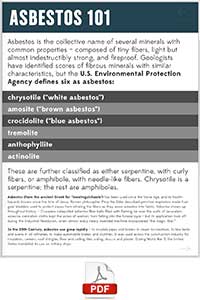Asbestos Facts
Its deadly nature has been known for thousands of years, but use spread to thousands of products during the Industrial Revolution. Today asbestos kills 10,000 Americans a year.
...

Asbestos is the collective name of several minerals with common properties – composed of tiny fibers, light but almost indestructibly strong, and fireproof. Geologists have identified scores of fibrous minerals with similar characteristics, but the U.S. Environmental Protection Agency defines six as asbestos:
- chrysotile (“white asbestos”)
- amosite (“brown asbestos”)
- crocidolite (“blue asbestos”)
- tremolite
- anthophyllite
- actinolite
These are further classified as either serpentine, with curly fibers, or amphibole, with needle-like fibers. Chrysotile is a serpentine; the rest are amphiboles.
Asbestos (from the ancient Greek for “inextinguishable”) has been used since the Stone Age and its health hazards known since the time of Jesus. Roman philosopher Pliny the Elder described primitive respirators made from goat bladders used to protect slaves from inhaling the fibers as they wove asbestos into fabric. Asbestos shows up throughout history – Crusaders catapulted asbestos-fiber balls filled with flaming tar over the walls of Jerusalem; asbestos cremation cloths kept the ashes of warriors from falling into the funeral pyre – but its application took off during the Industrial Revolution, when almost every newly invented machine incorporated “the magic fiber.”1
In the 20th Century, asbestos use grew rapidly – to insulate pipes and boilers in steam locomotives, to line tanks and ovens in oil refineries, to make automobile brakes and clutches. It was used across the construction industry for insulation, cement, roof shingles, floor and ceiling tiles, siding, stucco and plaster. During World War II the United States mandated its use on military ships.
At its peak from the 1940s to the 1970s, asbestos was the basis of thousands of consumer products – from cigarette filters to handheld hair dryers – and millions of Americans were exposed to the deadly fibers. Internal industry documents brought to light decades later through lawsuits by victims show in sickening detail that the makers and users of asbestos had known for decades that their products were killing workers but callously continued to conduct business as usual.
Asbestos fibers are microscopic, hundreds of times thinner than a human hair. When they become airborne, either through mining or release from products made with asbestos, they can easily be inhaled. The fibers lodge deep in the lungs or other organs, irritating the tissue and causing grave illnesses that can take from a decade to more than half a century to develop. According to the Occupational Safety and Health Administration, all types of asbestos are deadly and inhalation of a single fiber can be enough to cause disease.
The first case of asbestosis – an excruciatingly painful, often fatal, scarring of the lungs whose victims suffocate or suffer heart failure for lack of air – was reported in 1907.2 In ensuing decades links were found between asbestos and both conventional lung cancer and mesothelioma – a rare and always-fatal malignancy that can arise in the linings of the lungs, gastrointestinal system, heart or testicles. In 1964 a landmark study by Dr. Irving Selikoff of Mt. Sinai Hospital definitively established a cause-and-effect link.3
More than four decades after the danger became well known and asbestos use began to decline in some industries, these diseases still kill as many as 10,000 Americans a year. Because many people exposed long ago have yet to develop symptoms and an unknown number are being newly exposed, the death toll will continue to climb and could eventually reach half a million over the next 30 years.
1- Andrew Schneider and David McCumber, An Air That Kills: How the Asbestos Poisoning of Libby, Montana, Uncovered a National Scandal. New York: Berkley Publishing Group, 2004, p. 78.
2- H.M. Murray, Report of the Departmental Committee on Compensation for Industrial Diseases. London: His Majesty’s Stationery Office, 1907.
3- I.J. Selikoff, J. Churg, E.C. Hammond, Asbestos Exposure and Neoplasia. Journal of the American Medical Association, April 6, 1964.






